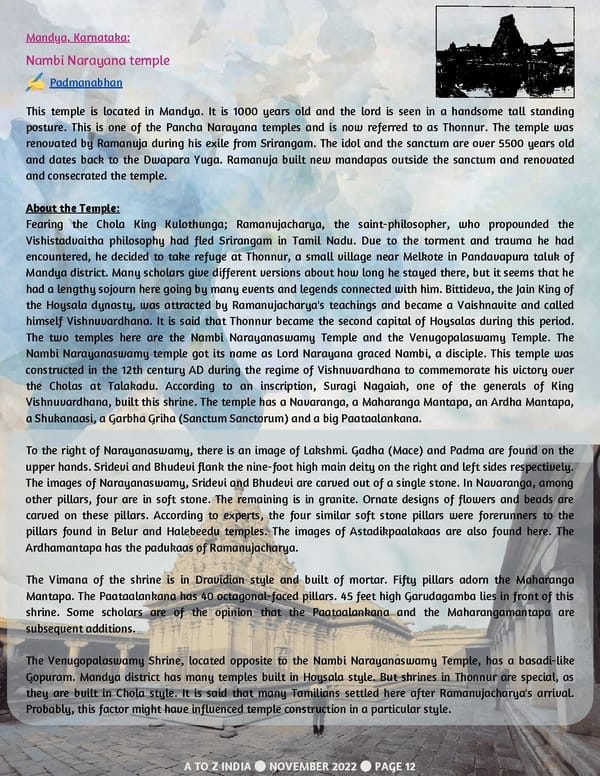Mandya, Karnataka: Nambi Narayana temple Padmanabhan This temple is located in Mandya. It is 1000 years old and the lord is seen in a handsome tall standing posture. This is one of the Pancha Narayana temples and is now referred to as Thonnur. The temple was renovated by Ramanuja during his exile from Srirangam. The idol and the sanctum are over 5500 years old and dates back to the Dwapara Yuga. Ramanuja built new mandapas outside the sanctum and renovated and consecrated the temple. About the Temple: Fearing the Chola King Kulothunga; Ramanujacharya, the saint-philosopher, who propounded the Vishistadvaitha philosophy had fled Srirangam in Tamil Nadu. Due to the torment and trauma he had encountered, he decided to take refuge at Thonnur, a small village near Melkote in Pandavapura taluk of Mandya district. Many scholars give different versions about how long he stayed there, but it seems that he had a lengthy sojourn here going by many events and legends connected with him. Bittideva, the Jain King of the Hoysala dynasty, was attracted by Ramanujacharya's teachings and became a Vaishnavite and called himself Vishnuvardhana. It is said that Thonnur became the second capital of Hoysalas during this period. The two temples here are the Nambi Narayanaswamy Temple and the Venugopalaswamy Temple. The Nambi Narayanaswamy temple got its name as Lord Narayana graced Nambi, a disciple. This temple was constructed in the 12th century AD during the regime of Vishnuvardhana to commemorate his victory over the Cholas at Talakadu. According to an inscription, Suragi Nagaiah, one of the generals of King Vishnuvardhana, built this shrine. The temple has a Navaranga, a Maharanga Mantapa, an Ardha Mantapa, a Shukanaasi, a Garbha Griha (Sanctum Sanctorum) and a big Paataalankana. To the right of Narayanaswamy, there is an image of Lakshmi. Gadha (Mace) and Padma are found on the upper hands. Sridevi and Bhudevi flank the nine-foot high main deity on the right and left sides respectively. The images of Narayanaswamy, Sridevi and Bhudevi are carved out of a single stone. In Navaranga, among other pillars, four are in soft stone. The remaining is in granite. Ornate designs of flowers and beads are carved on these pillars. According to experts, the four similar soft stone pillars were forerunners to the pillars found in Belur and Halebeedu temples. The images of Astadikpaalakaas are also found here. The Ardhamantapa has the padukaas of Ramanujacharya. The Vimana of the shrine is in Dravidian style and built of mortar. Fifty pillars adorn the Maharanga Mantapa. The Paataalankana has 40 octagonal-faced pillars. 45 feet high Garudagamba lies in front of this shrine. Some scholars are of the opinion that the Paataalankana and the Maharangamantapa are subsequent additions. The Venugopalaswamy Shrine, located opposite to the Nambi Narayanaswamy Temple, has a basadi-like Gopuram. Mandya district has many temples built in Hoysala style. But shrines in Thonnur are special, as they are built in Chola style. It is said that many Tamilians settled here after Ramanujacharya's arrival. Probably, this factor might have influenced temple construction in a particular style. A TO Z INDIA NOVEMBER 2022 PAGE 12
 A TO Z INDIA - NOVEMBER 2022 Page 11 Page 13
A TO Z INDIA - NOVEMBER 2022 Page 11 Page 13